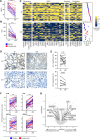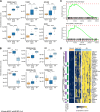Longitudinal paired liver biopsies and transcriptome profiling in alcohol-associated hepatitis reveal dynamic changes in cellular senescence
- PMID: 40122595
- PMCID: PMC12331437
- DOI: 10.1136/gutjnl-2024-334094
Longitudinal paired liver biopsies and transcriptome profiling in alcohol-associated hepatitis reveal dynamic changes in cellular senescence
Abstract
Background and aims: Alcohol-associated hepatitis (AH) is an acute form of alcohol-related liver disease (ALD) with high mortality rate. AH is histologically characterised by cellular processes, including steatosis, inflammation and cell death. Apoptosis is the most studied form of cell death in AH; however, the role of cellular senescence, another response to cellular injury, in AH is unknown. Here, we explore the mechanisms of ALD pathophysiology and describe the role of senescence in AH.
Methods: We performed RNA sequencing and bioinformatics analysis of 0- and 28-day transjugular liver biopsies (n=65) from patients with AH participating in the IL-1 Signal Inhibition In Alcoholic Hepatitis (ISAIAH) clinical trial. Additional bioinformatics reanalysis of existing AH transcriptomic datasets was conducted to confirm our findings. We also performed multiomic analysis of an in vitro model of AH with ethanol-treated hepatocytes overexpressing ethanol-metabolising enzymes.
Results: Our longitudinal analysis revealed that senescence and inflammation were reduced at transcriptomic level following AH resolution; the expression of hepatocyte markers was increased. We identified two senescence-associated protein complexes, cytochrome c oxidase and the proteasome, which may act as senescence-induction mechanisms. We confirmed that senescence markers and pathways were increasingly expressed in hepatocytes as ALD progressed towards AH; this was partially reversed following AH resolution. Our in vitro model revealed that ethanol directly induces senescence and was dependent on ethanol metabolism.
Conclusions: Our results suggest a possible pathogenic role for senescence in AH and indicate cellular senescence as a potential therapeutic target in early ALD to limit AH severity.
Keywords: ALCOHOLIC LIVER DISEASE; ETHANOL; INFLAMMATION; LIVER REGENERATION.
© Author(s) (or their employer(s)) 2025. Re-use permitted under CC BY. Published by BMJ Group.
Conflict of interest statement
Competing interests: AMK is a consultant for Resolution Therapeutics. SF-G is founder of SensiBile. MRT is a consultant for Surrozen, Hepatx, Resolution Therapeutics and Durect, and advisor for Intercept. SJF is founder of Resolution Therapeutics, SensiBile and an advisor of Cytotheryx.
Figures





References
-
- Vergis N, Atkinson SR, Knapp S, et al. In Patients With Severe Alcoholic Hepatitis, Prednisolone Increases Susceptibility to Infection and Infection-Related Mortality, and Is Associated With High Circulating Levels of Bacterial DNA. Gastroenterology. 2017;152:1068–77. doi: 10.1053/j.gastro.2016.12.019. - DOI - PMC - PubMed
MeSH terms
Substances
Grants and funding
LinkOut - more resources
Full Text Sources
